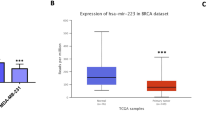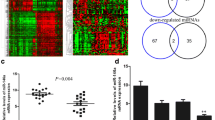Abstract
MicroRNAs (miRNAs) play critical role in normal breast development and their altered expression may lead to breast cancer. Identification of new miRNAs allows us to understand the normal physiological process and associated disease pathophysiology. In the present study we identify the novel miRNAs in withaferin A treated breast normal cells (MCF-10A) using small RNA sequencing. The pathophysiological potential of the identified miRNAs was checked by studying their expression pattern in MDA-MB-231 and MCF-7 breast cancer cells using qRT-PCR technique. The secondary/tertiary structure of the identified miRNAs, target gene enrichment in Gene Ontology terms and KEGG pathway, miRNA-mRNA interaction of the sorted target genes, miRNA-mRNA/miRNA-argonaute protein/miRNA-mRNA-argonaute protein interaction and stability, were studied using bioinformatics tools/software, and molecular dynamics simulations. Hsa-miR-N88585 and hsa-miR-N461089 were identified and validated as novel miRNAs in normal breast cells. Up-expression of identified miRNAs in MDA-MB-231 and MCF-7 cells indicates their oncogenic nature. Identified target genes were enriched in classical signaling pathways (AMPK and Ras) and important GO terms. PLXDC2, BHLHE40, ARMC8, and PECAM1, CDC27, KCNK3 genes were sorted as putative targets for hsa-miR-N88585 and hsa-miR-N461089, respectively. MD simulation revealed stable hsa-miR-N88585/hsa-miR-N461089-AGO protein complex formation which indicates their further processing. In conclusion, the study identifies hsa-miR-N88585 and hsa-miR-N461089 as novel miRNAs in breast normal cells which are significantly inversely expressed in breast cancer cells. Further experiments are required to study the role of identified novel miRNAs in normal breast development and pathophysiology of breast cancer.
Graphical abstract











Similar content being viewed by others
Data availability
The data that support the findings of this study are available in the supplementary material of this article and raw NGS data that were generated in the experiment was deposited in NCBI Gene Expression Omnibus (NCBI-GEO) accessible through GEO accession number GSE180247.
References
Shuaib M, Prajapati KS, Singh AK, Kushwaha PP, Waseem M, Kumar S (2021) Identification of miRNAs and related hub genes associated with the triple negative breast cancer using integrated bioinformatics analysis and in vitro approach. J Biomol Struct Dyn 39:1–15. https://doi.org/10.1080/07391102.2021.1961869
Prajapati KS, Shuaib M, Kushwaha PP, Singh AK, Kumar S (2021) Identification of cancer stemness related miRNA(s) using integrated bioinformatics analysis and in vitro validation. 3 Biotech 11:446. https://doi.org/10.1007/s13205-021-02994-3
Lee Y, Kim M, Han J, Yeom KH, Lee S, Baek SH, Kim VN (2004) MicroRNA genes are transcribed by RNA polymerase II. Embo J 23:4051–4060
O’Brien J, Hayder H, Zayed Y, Peng C (2018) Overview of microRNA biogenesis, mechanisms of actions, and circulation. Front Endocrinol (Lausanne) 9:402
Shukla GC, Singh J, Barik S (2011) MicroRNAs: processing, maturation, target recognition and regulatory functions. Mol Cell Pharmacol 3:83–92
Wilczynska A, Bushell M (2015) The complexity of miRNA-mediated repression. Cell Death Differ 22:22–33. https://doi.org/10.1038/cdd.2014.112
Reinhart BJ, Slack FJ, Basson M, Pasquinelli AE, Bettinger JC, Rougvie AE, Horvitz HR, Ruvkun G (2000) The 21-nucleotide let-7 RNA regulates developmental timing in Caenorhabditis elegans. Nature 403:901–906. https://doi.org/10.1038/35002607
Qu Y, Han B, Yu Y, Yao W, Bose S, Karlan BY, Giuliano AE, Cui X (2015) Evaluation of MCF10A as a reliable model for normal human mammary epithelial cells. PLoS ONE 10:e0131285. https://doi.org/10.1371/journal.pone.0131285
Mosmann T (1983) Rapid colorimetric assay for cellular growth and survival: application to proliferation and cytotoxicity assays. J Immunol Methods 65:55–63. https://doi.org/10.1016/0022-1759(83)90303-4
Friedländer MR, Mackowiak SD, Li N, Chen W, Rajewsky N (2012) miRDeep2 accurately identifies known and hundreds of novel microRNA genes in seven animal clades. Nucleic Acids Res 40:37–52. https://doi.org/10.1093/nar/gkr688
Wang X (2008) miRDB: a microRNA target prediction and functional annotation database with a wiki interface. RNA (New York, NY) 14:1012–1017. https://doi.org/10.1261/rna.965408
Rennie W, Liu C, Carmack CS, Wolenc A, Kanoria S, Lu J, Long D, Ding Y (2014) STarMir: a web server for prediction of microRNA binding sites. Nucleic Acids Res 42:W114–W118. https://doi.org/10.1093/nar/gku376
Yan Y, Tao H, He J, Huang SY (2020) The HDOCK server for integrated protein-protein docking. Nat Protoc 15:1829–1852. https://doi.org/10.1038/s41596-020-0312-x
Kushwaha PP, Maurya SK, Singh A, Prajapati KS, Singh AK, Shuaib M, Kumar S (2021) Bulbine frutescens phytochemicals as novel ABC-transporter inhibitor: a molecular docking and molecular dynamics simulation study. J Cancer Metastatis Treat 7:1–13
Jo S, Kim T, Iyer VG, Im W (2008) CHARMM-GUI: a web-based graphical user interface for CHARMM. J Comput Chem 29:1859–1865. https://doi.org/10.1002/jcc.20945
Huang J, MacKerell AD Jr (2013) CHARMM36 all-atom additive protein force field: Validation based on comparison to NMR data. J Comput Chem 34:2135–2145. https://doi.org/10.1002/jcc.23354
MacKerell AD Jr, Nilsson L (2008) Molecular dynamics simulations of nucleic acid–protein complexes. Curr Opin Struct Biol 18:194–199. https://doi.org/10.1016/j.sbi.2007.12.012
Brooks BR, Brooks CL III, Mackerell AD Jr, Nilsson L, Petrella RJ, Roux B, Karplus M (2009) CHARMM: the biomolecular simulation program. J Comput Chem 30:1545–1614. https://doi.org/10.1002/jcc.21287
Abraham MJ, Murtola T, Schulz R, Páll S, Smith JC, Hess B, Lindahl E (2015) GROMACS: High performance molecular simulations through multi-level parallelism from laptops to supercomputers. Software X 1:19–25. https://doi.org/10.1016/j.softx.2015.06.001
Evans DJ, Holian BL (1985) The nose–hoover thermostat. J Chem Phys 83:4069–4074. https://doi.org/10.1063/1.449071
Parrinello M, Rahman A (1981) Polymorphic transitions in single crystals: a new molecular dynamics method. J Appl Phys 52:7182–7190. https://doi.org/10.1063/1.328693
Hess B, Bekker H, Berendsen HJ, Fraaije JG (1997) LINCS: a linear constraint solver for molecular simulations. J Comput Chem 18:1463–1472. https://doi.org/10.1002/(SICI)1096-987X
Humphrey W, Dalke A, Schulten K (1996) VMD: visual molecular dynamics. J Mol Graph 4:33–38. https://doi.org/10.1016/0263-7855(96)00018-5
Shuaib M, Kumar S (2022) Induced expression of miR-1250-5p exerts tumor suppressive role in triple-negative breast cancer cells. J Cell Biochem. https://doi.org/10.1002/jcb.30362
Prajapati KS, Shuaib M, Gupta S, Kumar S (2022) Withaferin A mediated changes of miRNA expression in breast cancer-derived mammospheres. Mol Carcinog 61(9):876–889. https://doi.org/10.1002/mc.23440
Shuaib M, Prajapati KS, Gupta S, Kumar S (2023) Natural steroidal lactone induces G1/S phase cell cycle arrest and intrinsic apoptotic pathway by up-regulating tumor suppressive miRNA in triple-negative breast cancer cells. Metabolites 13(1):29. https://doi.org/10.3390/metabo13010029
Fan C, Zhao Y, Mao X, Miao Y, Lin X, Jiang G, Zhang X, Han Q, Luan L, Wang E (2014) Armc8 expression was elevated during atypia-to-carcinoma progression and associated with cancer development of breast carcinoma. Tumour Biol 35:11337–11343. https://doi.org/10.1007/s13277-014-2473-0
Wu Y, Sato H, Suzuki T, Yoshizawa T, Morohashi S, Seino H, Kawamoto T, Fujimoto K, Kato Y, Kijima H (2015) Involvement of c-Myc in the proliferation of MCF-7 human breast cancer cells induced by bHLH transcription factor DEC2. Int J Mol Med 35:815–820. https://doi.org/10.3892/ijmm.2014.2042
Montagner M, Enzo E, Forcato M, Zanconato F, Parenti A, Rampazzo E, Basso G, Leo G, Rosato A, Bicciato S, Cordenonsi M, Piccolo S (2012) SHARP1 suppresses breast cancer metastasis by promoting degradation of hypoxia-inducible factors. Nature 487:380–384. https://doi.org/10.1038/nature11207
Guan Y, Du Y, Wang G, Gou H, Xue Y, Xu J, Li E, Chan DW, Wu D, Xu P, Ni P, Xu D, Hu Y (2021) Overexpression of PLXDC2 in stromal cell-associated M2 macrophages is related to EMT and the progression of gastric cancer. Front Cell Dev Biol 9:673295. https://doi.org/10.3389/fcell.2021.673295
Miller-Delaney SF, Lieberam I, Murphy P, Mitchell KJ (2011) Plxdc2 is a mitogen for neural progenitors. PLoS ONE 6:e14565. https://doi.org/10.1371/journal.pone.0014565
Stevens KN, Wang X, Fredericksen Z, Pankratz VS, Cerhan J, Vachon CM, Olson JE, Couch FJ (2011) Evaluation of associations between common variation in mitotic regulatory pathways and risk of overall and high grade breast cancer. Breast Cancer Res Treat 129:617–622. https://doi.org/10.1007/s10549-011-1587-y
Ren YQ, Fu F, Han J (2015) MiR-27a modulates radiosensitivity of triple-negative breast cancer (TNBC) cells by targeting CDC27. Med Sci Monit 21:1297–1303
Smoot B, Kober KM, Paul SM, Levine JD, Abrams G, Mastick J, Topp K, Conley YP, Miaskowski CA (2017) Potassium channel candidate genes predict the development of secondary lymphedema following breast cancer surgery. Nur Res 66:85–94. https://doi.org/10.1097/NNR.0000000000000203
DeLisser H, Liu Y, Desprez PY, Thor A, Briasouli P, Handumrongkul C, Wilfong J, Yount G, Nosrati M, Fong S, Shtivelman E, Fehrenbach M, Cao G, Moore DH, Nayak S, Liggitt D, Kashani-Sabet M, Debs R (2010) Vascular endothelial platelet endothelial cell adhesion molecule 1 (PECAM-1) regulates advanced metastatic progression. Proc Natl Acad Sci USA 107:18616–18621. https://doi.org/10.1073/pnas.1004654107
Wade RC, Goodford PJ (1989) The role of hydrogen-bonds in drug binding. Prog Clin Biol Res 289:433–444
Acknowledgements
S.K. acknowledges the Department of Science and Technology, India for providing financial support in the form of the DST-SERB Grant [EEQ/2016/000350]. S.K. also acknowledges DST-India for providing a Departmental grant to the Department of Biochemistry, Central University of Punjab, Bathinda, India in the form of the DST-FIST grant. K.S.P. and A.K.S acknowledge DBT, India and CSIR-India for providing financial assistance in the form of Senior Research Fellowship.
Funding
This work was supported by Department of Science and Technology, India for providing financial support in the form of the DST-SERB Grant [EEQ/2016/000350].
Author information
Authors and Affiliations
Contributions
SK designed the study, SK supervised all analyses and experiment, MS, KSP and AKS performed the experiments, SK, MS, and KSP performed statistical analysis, SK wrote the first draft of the manuscript. All the authors have read and accepted the final version of the manuscript.
Corresponding author
Ethics declarations
Conflict of interest
The authors declare no conflict of interest.
Additional information
Publisher's Note
Springer Nature remains neutral with regard to jurisdictional claims in published maps and institutional affiliations.
Supplementary Information
Below is the link to the electronic supplementary material.
Rights and permissions
Springer Nature or its licensor (e.g. a society or other partner) holds exclusive rights to this article under a publishing agreement with the author(s) or other rightsholder(s); author self-archiving of the accepted manuscript version of this article is solely governed by the terms of such publishing agreement and applicable law.
About this article
Cite this article
Shuaib, M., Prajapati, K.S., Singh, A.K. et al. Discovery of differentially expressed novel miRNAs in breast normal cells and their putative targets. Mol Cell Biochem 478, 2361–2378 (2023). https://doi.org/10.1007/s11010-023-04665-8
Received:
Accepted:
Published:
Issue Date:
DOI: https://doi.org/10.1007/s11010-023-04665-8




